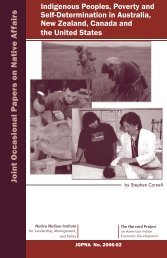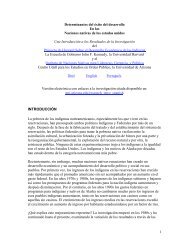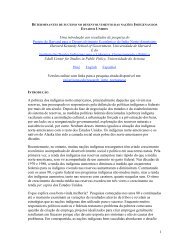American Indian Self-Determination - Native Nations Institute ...
American Indian Self-Determination - Native Nations Institute ...
American Indian Self-Determination - Native Nations Institute ...
- No tags were found...
You also want an ePaper? Increase the reach of your titles
YUMPU automatically turns print PDFs into web optimized ePapers that Google loves.
<strong>American</strong> <strong>Indian</strong> <strong>Self</strong>-<strong>Determination</strong>Stephen CornellJoseph P. KaltWith its start marked most saliently by the passage in 1975 of the <strong>Indian</strong><strong>Self</strong>-<strong>Determination</strong> and Education Assistance Act (US Public Law 95-638), the era of formal policies of tribal self-determination began withhalting steps. The vast majority of tribes embarked on strategies ofmeaningful self-rule under conditions of stark poverty, utilizing externallydesigned governmental systems, 21 lacking meaningful experiencein business and governmental decision making among the living population,and bearing legacies of federally-imposed systems of education.By the second half of the 1980s, however, self-determination had becomea widespread and systematic restructuring of tribal governmentsand their relations with the federal government. This restructuringhas acquired a name as the “nation building” movement. It is beingmanifested by wholesale changes in tribal institutions and policies asthe <strong>Indian</strong> nations themselves rewrite their constitutions, generate increasingshares of their revenues through their own taxes and businessenterprises, establish their own courts and law enforcement systems,remake school curricula, and so on, across the panoply of functionscommonly associated in the United States with state governments.B. Tribal <strong>Self</strong>-Government and the Reasons forDevelopment ProgressNot only is the pace of development remarkable, but also its characterin the current era of federal policies of self-determination is dramaticcompared to what preceded it. The Tohono O’odham Nation outsideof Tucson, Arizona, for example, funded, built, and now operates thefirst either <strong>Native</strong> or non-<strong>Native</strong> elder care facility to achieve the highestlevel of federal quality rating for health care provision. The CitizenPotawatomi Nation (“CPN”) in Oklahoma has engaged in constitutionalreform over the last two decades that has resulted in a judicialsystem of trial and appeals courts that function at a level of sufficientlyhigh quality such that it has attracted tens of millions of dollars ofcapital to the Nation’s business enterprises and induced a neighboringnon-<strong>Indian</strong> township to opt into the Potawatomi system and out ofthe State of Oklahoma system for its municipal court services. Whilea number of tribes operate well-known casino gambling and relatedresort enterprises, less well-known are the tribes, such as the ChickasawNation, whose Chickasaw Nation Industries provides programmanagement, information technology, technical and administrativesupport, medical and dental staffing, aviation and space technical support,construction, manufacturing, property management, and logis-11







